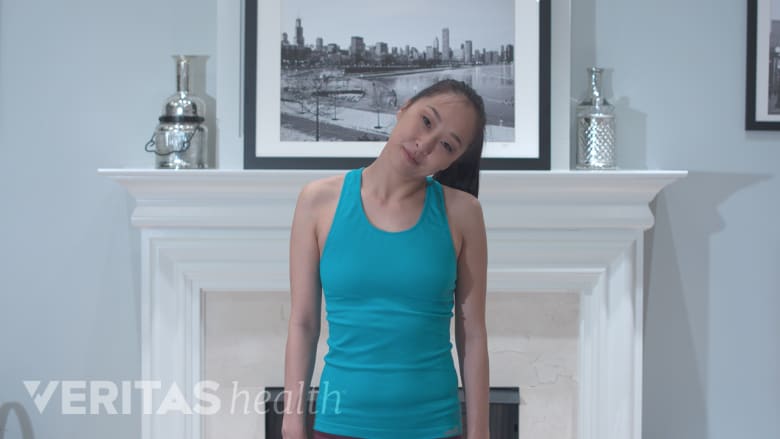Even though a stiff neck is typically caused by a relatively minor injury, such as a muscle strain or ligament sprain, the painful flare-ups can be quite sharp or burning. It is good to minimize painful movements and give a stiff neck some rest, but it is also important to keep the neck moving to avoid further stiffening or muscle deconditioning.
This article includes 4 easy stretches to improve neck flexibility and function, as well as test which movements may need to be modified or avoided until the neck feels better. Some of these stretches may feel good or help reduce pain and stiffness, whereas others may not. If a particular movement starts to increase pain, immediately stop it and try a different movement.
Neck Extension (Backward Bending)
Neck extension exercises help improve neck flexibility, relieve tension, and enhance posture.
Gently extend the neck by looking upward and bringing the head backward while keeping the shoulders and back stationary. Once the head has gone back as far as it can go without increasing pain, try to hold the stretch for 5 seconds before returning the head to neutral (starting) position.
During a neck extension exercise, the stretch is felt along the front of the neck through the throat. The muscles working at the back of the neck may also be felt, from the base of the skull all the way down to the upper back.
Neck Flexion (Forward Bending)
Gradually lower the chin toward the chest and look downward while only moving the head. Once the head has been flexed forward as far as it can comfortably go, hold the stretch for 5 seconds before returning to neutral position.
The neck flexion stretch is felt throughout the back of the neck.
Lateral Neck Flexion (Bending Side to Side)

Lateral neck flexion exercises stretch the muscles that aid in tilting and rotating the head.
Slowly bend the head to one side, such as by bringing the left ear toward the left shoulder. During this stretch, the shoulders and back remain still while the neck flexes laterally to the side. Once the head has flexed as far as it can comfortably go to the side, try to hold the stretch for 5 seconds before returning the head to neutral position. This stretch is then repeated in the opposite direction.
When the lateral neck flexion is performed with the head bending toward the left shoulder, the stretch is felt along the right side of the neck.
Neck Rotation (Turning Side to Side)
Neck rotation exercises improve neck muscle flexibility and motion.
While keeping the back straight and shoulders still, gradually turn the head to the left as far as it can naturally go without increasing pain. Once the head has reached its rotation limit, hold the stretch for 5 seconds before bringing it back to neutral position. This same stretch is then repeated to the right.
Of all these stretches noted for a stiff neck, rotation is often the most challenging, especially on one side or the other. It is recommended to only rotate the neck partway if that is all that can be done without increasing pain.
How Often to Perform Neck Stretches
For an acute stiff neck that is particularly painful and difficult to move, it may make sense to only try each of these stretches once before giving it a rest. These stretches could then be tried again a few hours later, or perhaps the next day.
As time goes on, these stretches may start to feel more comfortable and can be increased, such as by holding the stretch positions for 10 seconds, or doing multiple sets. At each step of the way, it is important to remember that the goal is to improve neck flexibility and function, not increase pain.
Watch 3 Gentle Stretches to Prevent Neck Pain Video
After the initial neck pain and stiffness have been reduced, a more involved routine of neck strengthening and stretching might be pursued long-term to reduce the risk of having the pain return.
When to Seek Medical Attention
If a stiff neck is accompanied by a severe headache, fever, nausea, dizziness, arm tingling, weakness, or other troubling symptoms, seek medical attention immediately.
See When Is a Stiff Neck Serious? and What Causes Neck Pain and Dizziness?
Also, if a person has a history of serious medical conditions, or if neck pain or stiffness do not start to get better within a few days, it is advisable to schedule a doctor appointment before continuing exercises.

